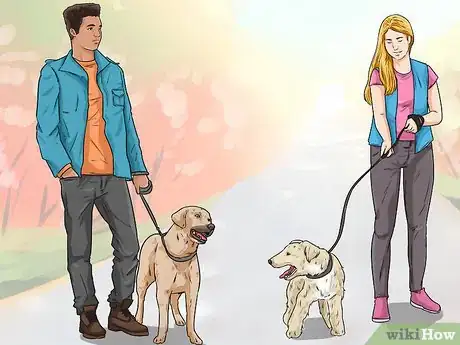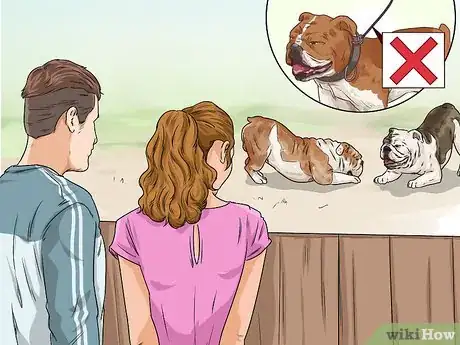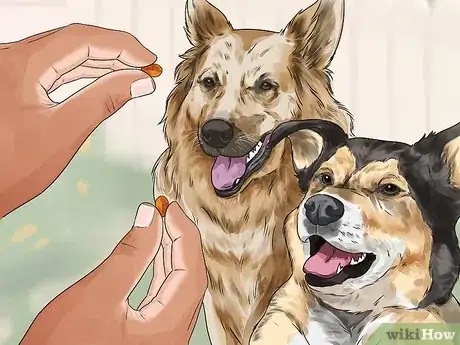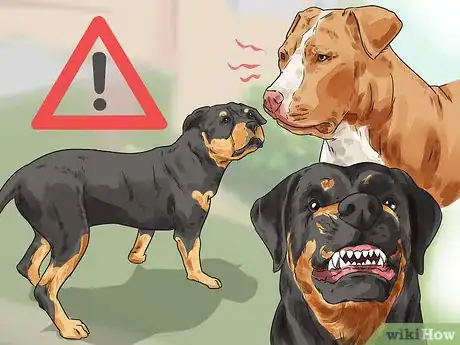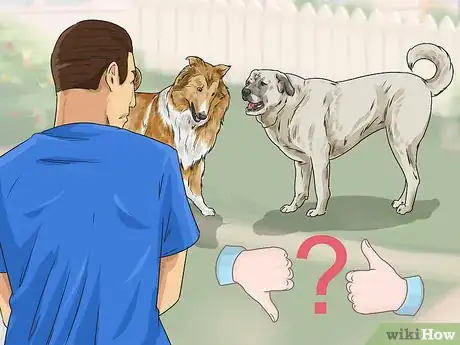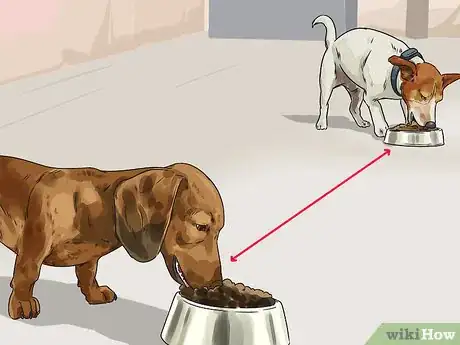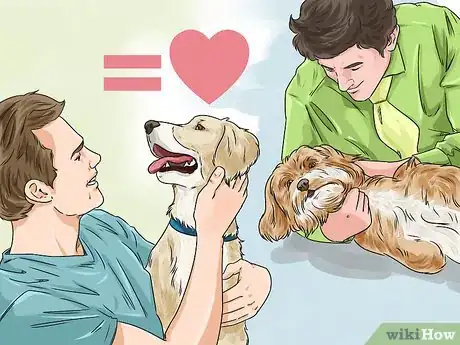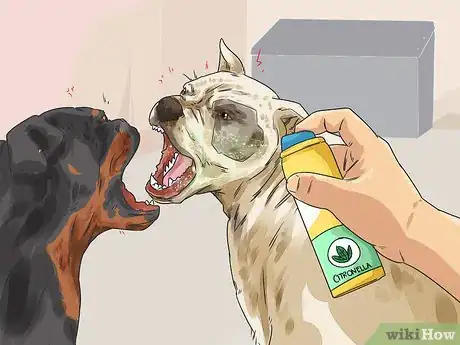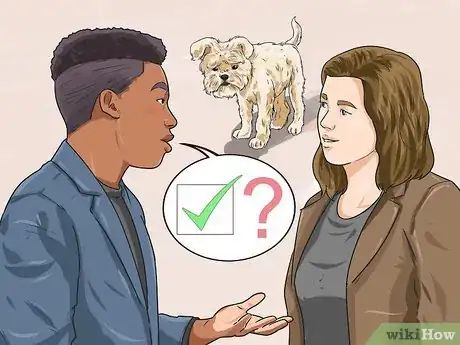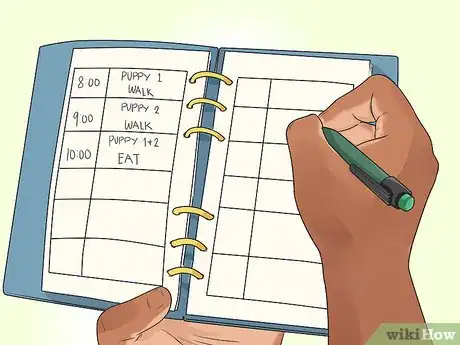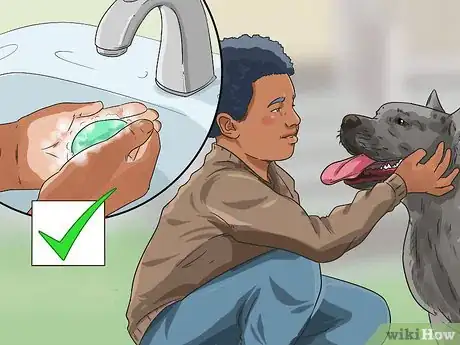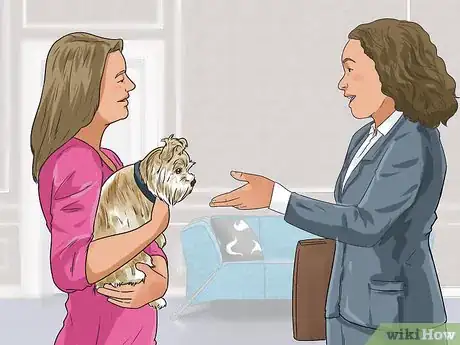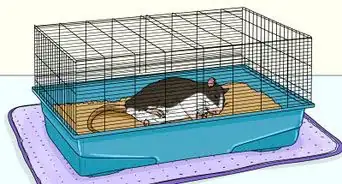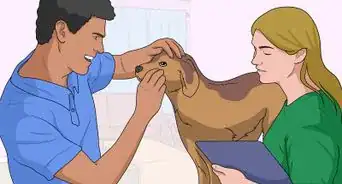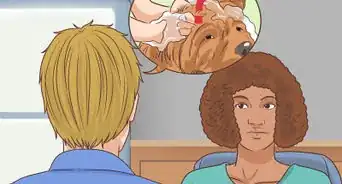This article was co-authored by Ryan Corrigan, LVT, VTS-EVN. Ryan Corrigan is a Licensed Veterinary Technician in California. She received her Bachelor of Science in Veterinary Technology from Purdue University in 2010. She is also a Member of the Academy of Equine Veterinary Nursing Technicians since 2011.
There are 9 references cited in this article, which can be found at the bottom of the page.
This article has been viewed 28,326 times.
Dog-sitting is a big responsibility, and it can become tricky when you have your own dog to look after. Typically, while dog-sitting, you either bring the dog into your house or you visit the dog at theirs. If you want to watch the dogs together in the same house, you should make sure that they are introduced properly before the other owner leaves. Once you bring the dogs together, you will have to keep a careful eye on them to make sure that there are no conflicts. If you are not planning on bringing the dog to your own house, you should make sure that you can evenly divide your time between the other dog’s house and your own.
Steps
Introducing the Dogs
-
1Take them both outside. The dogs should be introduced on neutral territory. The best place to do this is outside. Have the other dog’s owner hold them on a leash while you hold your own dog. It is important that they are both leashed so that you can separate them if they don’t get along.[1]
- Try taking the dogs to a neutral location, like a nearby dog park. Just make sure you keep their leashes on at all times so you can separate them if needed.
-
2Walk towards each other. You should both start at a distance from one another. Slowly walk towards each other. The dogs may or may not notice each other. If they let you, bring them together. They may start to sniff one another at this point.[2]
- Pay attention to your dog's body language during the interaction. It's normal for dogs to whine or bark at each other when they want to play. However, if you notice that your dog's ears are pinned back, its muscles are tense, or its tail isn't moving, it's a sign that your dog is uncomfortable with the meeting.
- If your dog growls or the hair on its back and neck lifts, you may pause. Pet your dog and talk to them to soothe them. When they have calmed down, continue walking towards the other dog.[3]
Advertisement -
3Drop their leashes. If the dogs do well on their leashes, you should bring them to an enclosed location, such as a fenced yard. Drop their leashes, and see how they react towards one another. If they start to play or if they ignore each other, it is a good sign that they will get along.[4]
- Dogs will often bow with their front legs pressed down and their hind quarters lifted. Although it can be mistaken for aggression, it actually a sign of play. Other signs of play include bouncing and exposing their stomachs. They should also take turns when playing chase.[5]
-
4Reward them both for good behavior. If the dogs are friendly with one another or if they play nicely, you should reward both of them with a small treat. This will teach them to associate the other dog with positive reactions, and they may be more motivated to keep up the good work.[6]
-
5Watch for signs of aggression. Dogs can express fear or aggression in many ways, but you do not want it to get to the point where they are biting or fighting with the other dog. If you notice any signs of aggression, separate the dogs. Wait until they calm down, and try again. If the dogs do not get along with one another, you may not be able to watch both dogs together. Some signs of aggression include:
Bringing the Dog into Your Home
-
1Separate them with baby gates. When you first bring the other dog into your home, you should not let them run free right away. Even if your dog was friendly outside, they may not be comfortable with a new dog in their territory. Separate them from each other using baby gates. The dogs may sniff one another through the gate. Watch them closely. If they bark, growl, or snap at each other, you may need to keep them separated for the entire stay.
-
2Supervise them carefully. If the dogs seem fine with each other’s presence through the baby gates, you might consider letting them out to play with one another. During these sessions, you should be present to watch the dogs. Keep an eye out for aggressive or territorial behavior.[9]
- Your dog may not like that the visiting dog is playing with their toys or sleeping in their bed. Even if you think that the dogs are best friends, you should keep watching them in case an argument occurs.
- Bring the visiting dog's toys and bedding along so both dogs have their own belongings.
- When you leave the home, you may want to separate and confine the dogs. This will prevent a fight while you're gone.
-
3Move the food bowls. Many dogs are territorial over their food bowls. When the other dog comes into your home, you should move your dog’s bowl to a place where the other one cannot reach it. Feed the dogs in separate confined rooms to prevent conflict. Remove the food bowls when they are finished eating.[10]
- Dogs can also fight over treats, bones, or high-value toys, such as Kong toys.[11] Either give both dogs a treat at the same time or avoid giving them treats altogether.
-
4Give the dogs equal attention. Dogs can become jealous and protective over a human. If you pay attention to one dog more than the other, it could cause problems. You do not want to ignore your dog in favor of your canine guest or vice versa, but you still need to make sure that the other dog receives enough attention, exercise, play, and treats. Divide your time equally between the two.[12]
-
5Break up any fights. If the dogs do get into a fight, you will need to stop it. It can be dangerous to interfere with a dog fight, so practice caution when doing so. Always grab the dogs from behind. Do not step between them or else you might be injured as well.
- Grab your dog by the rear and pull them away. Put them in a separate, closed-off area.
- Ask someone else at home for help breaking up the fight.
- Use a deterrent spray such as citronella spray, Direct Stop, or Spray Shield.
- You can also use a long broom or a chair to separate the dogs.
- If your dog is the aggressor, you may be able to use a simple command such as “Stop” or “come here” to distract them.
- Never break up a fight by grabbing the dog’s face, neck, or collar, as you might be accidentally bitten.[13]
Splitting Your Time Between Dogs
-
1Ask the owner for instructions. The owner should leave behind some instructions for caring for their dog. This can tell you when the other dog needs to be fed, exercised, or medicated. Read over these instructions carefully, and consider how they fit into your normal routine.
- If the dog needs to be walked at the same time that you usually walk your own dog, you should consider which dog needs to be walked first. For example, an older dog may not be able to wait to go outside like a younger dog.
- Make sure you ask the owner where the dog’s food, bowls, and medication are located so that you can feed them efficiently before returning to your own dog.
- If there is an emergency with the other dog, you should have their vet’s number handy. Think about who you can call to care for your dog while you take the other dog to the vet.
-
2Create a schedule for both dogs. To make sure that both dogs get an equal amount of attention, you should create a schedule that will last for the entire duration of your dog sit. This should list how you plan to split your time between two households and two dogs. Remember that the dog you are pet sitting for will need plenty of exercise during the day, and they will also need to be let outside to eliminate. That said, do not neglect your own dog during this time.
- Visit the other dog at least three times a day: once in the morning, once in the late afternoon, and once in the later evening. Make sure to let the dog outside, walk them, play with them for a little while, and feed them.[14]
- At least one of these visits should be an extended visit, when you play and talk to the dog for a longer period of time. This will keep the other dog from becoming bored and destructive.
- Don't leave the dogs inside for longer than 10 hours at a time.
- If you're watching an older dog or a dog with a disability, they may not want to spend a lot of time playing outside. Instead, you can cuddle with them on the couch and watch a movie or read a book.
- Don't forget to take your travel time into consideration when you're making a schedule for the dogs.
-
3Wash your hands before petting your dog. There are many diseases that can pass between dogs, and some of these can survive on your hands.[15] Before petting your dog when you get home, wash your hands to make sure that you do not spread any illnesses from the other dog.
- Just because the other dog doesn’t look sick doesn’t mean that they are not carrying germs.
- Washing your hands can also help reduce the scent of the other dog on you. Your dog can probably smell the other dog, and this may cause them anxiety or discomfort.
-
4Ask a family member to look after your dog. If you have multiple people in your household, you can ask someone else to take over dog duty while you dog sit. This will ensure that your dog has plenty of attention and care while you are looking after someone else’s dog.
Warnings
- Make sure the other dog is comfortable around you. You should not dog sit for a dog that is aggressive towards you.⧼thumbs_response⧽
- Make sure the other dog is vaccinated before bringing them around your own dog.⧼thumbs_response⧽
References
- ↑ http://www.humanesociety.org/animals/dogs/tips/introducing_new_dog.html
- ↑ http://bestfriends.org/resources/introducing-dogs-each-other
- ↑ http://www.humanesociety.org/animals/dogs/tips/introducing_new_dog.html
- ↑ http://bestfriends.org/resources/introducing-dogs-each-other
- ↑ http://www.akc.org/content/dog-training/articles/are-they-playing-or-fighting/
- ↑ http://www.humanesociety.org/animals/dogs/tips/introducing_new_dog.html
- ↑ http://www.aspca.org/pet-care/dog-care/common-dog-behavior-issues/aggression
- ↑ http://www.humanesociety.org/animals/dogs/tips/introducing_new_dog.html
- ↑ http://www.humanesociety.org/animals/dogs/tips/introducing_new_dog.html
- ↑ http://clubs.akc.org/aba/bully/multiple.htm
- ↑ http://bestfriends.org/resources/introducing-dogs-each-other
- ↑ http://www.thedogtrainingsecret.com/blog/dog-share-affections-dogs/
- ↑ https://drsophiayin.com/blog/entry/how-to-break-up-a-dog-fight-without-getting-bitten/
- ↑ http://articles.chicagotribune.com/2013-05-16/features/sc-fam-0514-pet-sitting-etiquette-20130514_1_pet-owners-pet-food-other-pets
- ↑ https://www.avma.org/public/PetCare/Pages/Disease-Risks-for-Dogs.aspx
